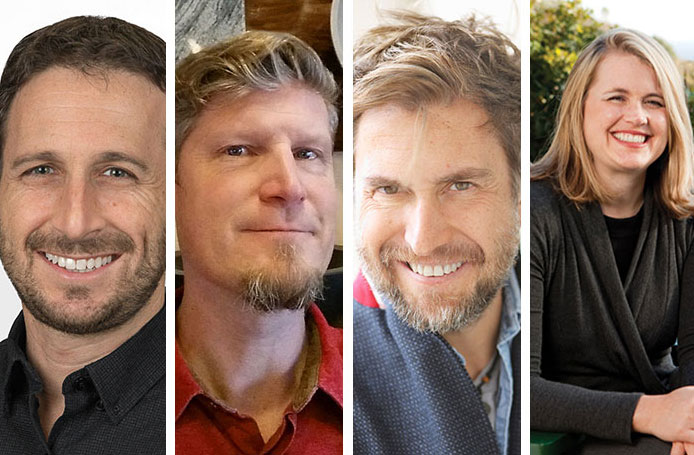
From right to left: Jason Silverstein, Elkay; Michael Cahill, Stone Forest; Miguel Herranz, Nerinea; Naomi Neilson, Native Trails
Plumbing fixtures are steadily becoming the jewelry of the kitchen and bath. From decorative apron fronts to deep basins with elaborate designs on the interior, the sink is more often being chosen as the highlight of a space.
With this in mind, KBB spoke with four prominent sink designers to find out more about their daily job, the challenges they face and the experiences and people that inspire their creations.
The Job Description
“At Elkay, our design team touches all aspects of the development process. There’s of course keeping up with design trends and ideating, but we spend a ton of time doing customer research and really trying to understand their pain points and emotional drivers. We also spend a lot of time with our engineering team to understand the latest on materials and manufacturing processes, because at the end of day, a great design concept means nothing if we can’t bring it to life.”
– Jason Silverstein, global insights and design manager at Elkay
“Basically, my job as a product designer is to create products that meet the objectives and conditions of my client. I always try to follow a commercial approach. And when I say commercial, I’m not exclusively referring to sales but to the capacity of connecting with society. Because I believe that in order to achieve commercial success, an emotional connection is essential, and that is why I always try to create products with a soul.”
– Miguel Herranz, designer, Nerinia
“I think one of the most important aspects of designing products is to anticipate what people need or want before they know it. In the case of Native Trails and most luxury products, we create a more visceral need. Our products are handmade and full of tradition – each has a back story – and that creates a sort of emotional connection that we all crave.”
– Naomi Neilson, founder/CEO of Native Trails
“As one of the designers at Stone Forest, my job is to assist the team in realizing the final product from initial concept through production and to market. This could be guidance on material tolerances, to looking at current trends to see where a new idea fits in or drafting out any of those new ideas to tweak in our 3D CAD software.”
– Michael Cahill, designer, Stone Forest
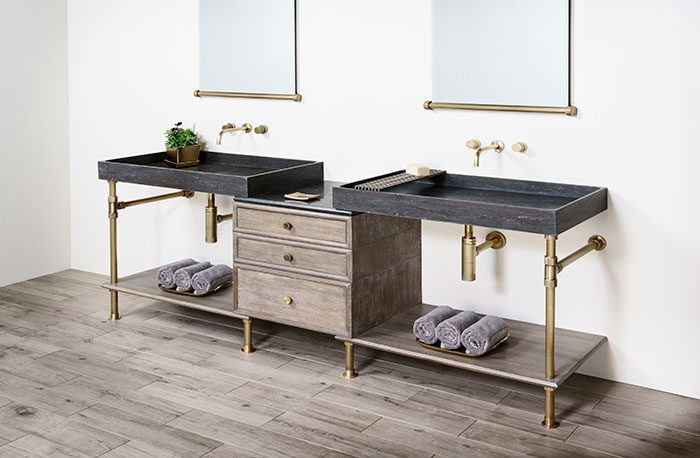
The Elemental Collection from Stone Forest comprises of brass legs with knurled fittings supporting a combination of stone, wood and steel components. This modular concept allows the user to combine integral stone sinks, wood drawers and steel or wood shelving in unlimited combinations to create bath consoles and stand-alone storage systems.
Why Sinks?
“I love working on sinks because they’re such relatable, critical fixtures in our homes. While not always the sexiest product, everyone uses and needs sinks. It’s great working on something that touches so many lives and helps get things done!
– Silverstein, Elkay
“In 2000, I designed my first collection of bathroom furniture, winning the international design competition organized by CEVISAMA. Since then I have done [lots of] design and creative direction work for bathroom products. It is a sector I find especially interesting because of its relationship with water, which is an element I adore.”
– Herranz, Nerinia
“One day it occurred to me that we could turn everyday, functional objects into art. We collaborate with incredible artisans who were very excited to apply their expertise to what was, back then, an entirely new area. At Native Trails we combine age-old artistic tradition with modern design to create these wonderfully functional, feel-good pieces for the kitchen and bath.”
– Neilson, Native Trails
“It’s been a slow progression into the design aspect of our products. The first of our kitchen and bath sink designs almost 30 years ago was inspired by our outdoor garden line and highlighted the material and craftsmanship involved in the process. Looking back, they were very simple designs, but [were also] revolutionary. My role on the design side of our products has slowly grown from strictly drafting those original designs to being more involved in concept development from stage one.”
– Cahill, Stone Forest
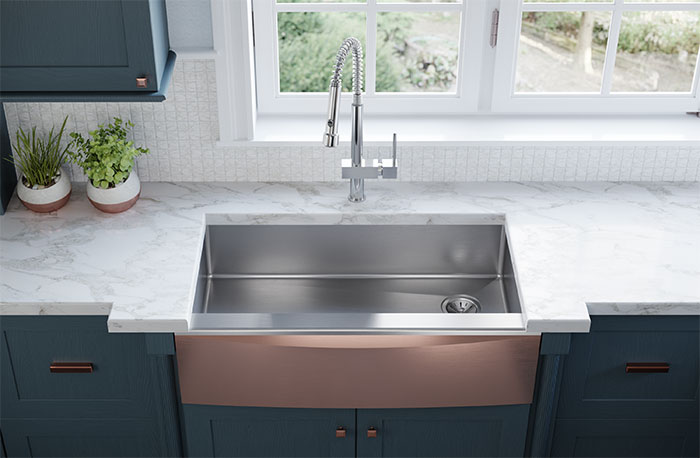 The Elkay Crosstown stainless steel farmhouse sink with an interchangeable apron front allows homeowners to easily swap out the apron as desired, choosing a variety of colors – Fireclay or Black Stainless for a classic everyday look or Jubilee Blue or Maraschino Red for the holiday. According to Silverstein, the design allows self-expression without the fear of making a design misstep.
The Elkay Crosstown stainless steel farmhouse sink with an interchangeable apron front allows homeowners to easily swap out the apron as desired, choosing a variety of colors – Fireclay or Black Stainless for a classic everyday look or Jubilee Blue or Maraschino Red for the holiday. According to Silverstein, the design allows self-expression without the fear of making a design misstep.
Challenges of the Process
“Our research shows that most homeowners put high value on choosing the right sink design and understand that not all sinks are the same. However, during the chaos of a kitchen remodel, the sink decision can get buried by the tidal wave of other big decisions. After a homeowner has lived with it, they might find themselves dissatisfied with their decision. There’s definitely an opportunity for the sink industry to help educate homeowners on all the great options they have prior to purchase and also an opportunity to work with counter and cabinet teams to make higher-end sinks easier to change out vs. being semi-permanent fixtures forever tied to remodels.”
– Silverstein, Elkay
“Logically, the main challenge is always to achieve the objectives set. In this mission, the real challenge is to combine the emotional force with the functional, production, profitability and commercial hook requirements.”
– Herranz, Nerinia
“It is always a challenge designing products to be entirely handcrafted. We often work with the artisans to create new methods to achieve the intended design, and we sometimes have to adjust the design to fit the capabilities of the artisans. Often, we present a design challenge and the artisan will work at it until s/he comes up with a solution; there is an incredible level of skill and expertise that comes with generations of artistry, and we always try to tap into that to create the most interesting results. Finding the balance between perfection and humanity is not easy, yet it is one of the things that Native Trails has become really good at.”
– Neilson, Native Trails
“I think it’s the same with any company and design team – the challenge is coming up with new ideas. We do have the benefit of working in many different natural materials, which eases the difficulty of new shapes and ideas that are encountered when only working in one. However, it also poses the challenge of getting all our artisans to combine the materials as precisely as possible. A prime example is our new Elemental Collection. It mixes wood, stone and brass with expert skill and balance. It helps to have such great craftspeople on staff to pull of the ideas and help overcome any challenges.”
– Cahill, Stone Forest
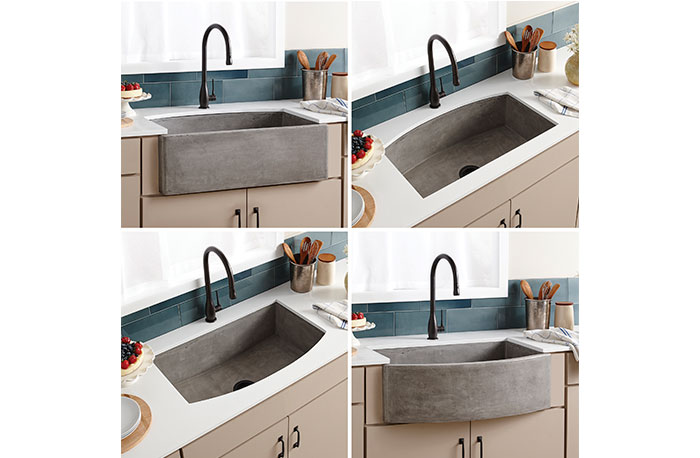
“Creating our Farmhouse Quartet, a concrete kitchen sink in our NativeStone Collection from NativeTrails, was a lot of fun,” said Neilson. “I wanted to create the most versatile and beautiful sink on the market, and I designed it to install four ways. It has been a huge success, and I love seeing that people truly do install it all different ways, depending on their space and preferences.”
Finding Inspiration
“End users are my inspiration. Whether it’s a formal online survey or stalking the hosts at a dinner party while they do dishes, I’m constantly pitching ideas and watching people for inspiration. Lately, a lot of my inspiration has also come from restaurants and food-service locations; seeing food prep and cleaning in those extreme, professional settings definitely sparks unique ideas for the residential space. I also love researching building materials (naturals and synthetics) for inspiration.”
– Silverstein, Elkay
“I work with an analytical-anarchical creative process that I call the ‘Conceptual Nebula.’ This process makes it possible to create conceptual tools for real solutions based on analyzing the three core elements found in every project: culture, industry and society. I apply this process for product design and for creative direction, design thinking or design management.”
– Herranz, Nerinia
“Inspiration comes from many places, but the most important thing is to clear the mind and allow the creative energy to flow. I often find myself most inspired while traveling, especially when I disconnect, explore and open my mind.”
– Neilson, Native Trails
“Kitchen and bath products have become high fashion. My inspiration might not be directly from the runway, but it comes from everyday items and shapes that inspire other artists around the world – whether it’s functional or sculptural. I also find inspiration in nature and the materials we work in. You’ll always know the material in our product collections no matter the design or configuration.”
– Cahill, Stone Forest
Best Part of the Job
“I love working as part of a larger product development team, not only with my fellow Elkay designers and engineers but all of the cross-functional partners needed to bring a product to life – from customers to manufacturing suppliers and everyone in between. It takes more than one designer to bring a great design idea to market.”
– Silverstein, Elkay
“I really love my job. I love the analytical phase in which I approach the project, observing very generic conceptual aspects related to it. I really like the moment when I find the way to go and implement it. And finally, every time I like more the moment in which I generate the right atmosphere to present the project through a singular language that emphasizes its virtues and follows the same conceptual approach.”
– Herranz, Nerinia
“Working with an artisan to see a design concept come to fruition is always exciting, and it is incredibly fulfilling to be a part of maintaining the artisan tradition in that family or region. Every successful product we launch impacts the continuation and growth of artisan traditions that are a huge part of a peoples’ cultural legacy. To me, this is the most important part of my work: helping age-old artisan traditions flourish, rather than languish, and seeing artisan families thrive where they may have struggled before.”
– Neilson, Native Trails
“I love seeing the end product in someone’s home. It’s one thing to be able to turn the ideas around in the CAD program and get them to an almost final point, but it’s the best feeling when one of those products is first created and is placed in a functional environment that is designed around it.”
– Cahill, Stone Forest
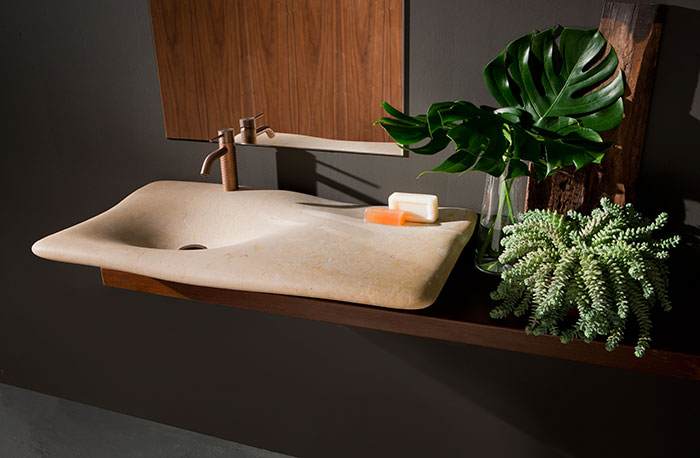 Designed by Miguel Herranz for Nerinea, Flow is a sculptural piece with gently flowing surfaces. The unusual design gives the sink a lightweight appearance while supplying plenty of countertop space. In addition, the slightly recessed base allows the sink to rest on countertops that are only 35cm deep, making it an ideal solution for small spaces.
Designed by Miguel Herranz for Nerinea, Flow is a sculptural piece with gently flowing surfaces. The unusual design gives the sink a lightweight appearance while supplying plenty of countertop space. In addition, the slightly recessed base allows the sink to rest on countertops that are only 35cm deep, making it an ideal solution for small spaces.
You can read the original story on KBBOnline.com here.








